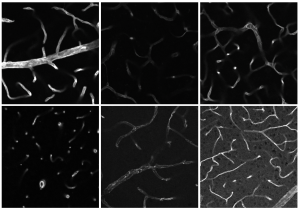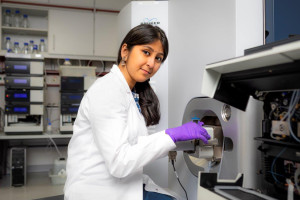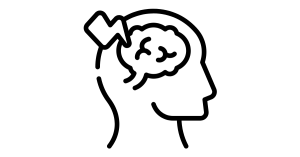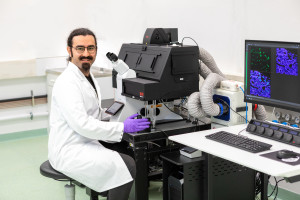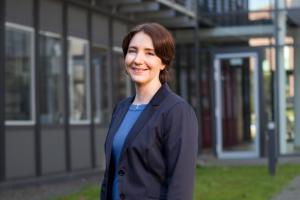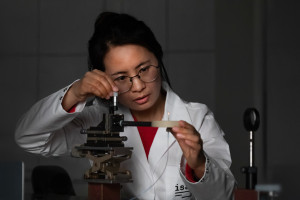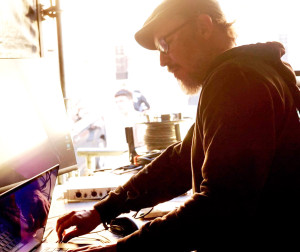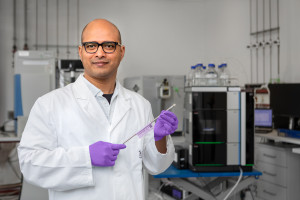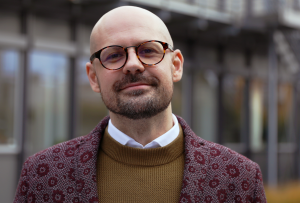Dortmund, 26th June 2024
Prof Dr Anika Grüneboom, immunologist and head of the Bioimaging research group, spends several month without her two doctoral candidates Darleen Hüser and Flora Weber. Since the two up-and-coming researchers headed for the USA, they are missed by the ISAS research group – but Grüneboom is certain that ultimately all those involved will benefit from this research sojourn. She wants to inspire as many young scientists as possible to get involved in research outside Germany at some point.
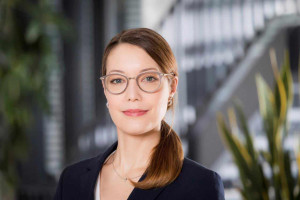
Prof Dr Anika Grüneboom heads the research group Bioimaging at ISAS.
© ISAS / Hannes Woidich
1. You supported your doctoral candidates in gaining this experience abroad. Why is this important to you?
Grüneboom: I generally want my team members to see how other research groups approach their work. When you live and work abroad, you learn about self-organisation and how to adapt to new processes in an unfamiliar environment. It is also important to start networking early on, both nationally and internationally. When they go abroad, doctoral candidates get to know cooperation partners on a personal level. This time they spend together can undoubtedly lay the foundations for lifelong professional ties. I'm speaking from experience: when I started my PhD, I spent two weeks at the University of Bern. I was actually going to study the technology of optical projection tomography but I randomly stumbled upon a light sheet fluorescence microscope during my time there.
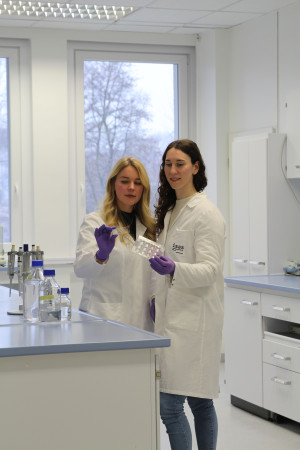
Darleen Hüser (left) and Flora Weber not only share an office at ISAS, but also spend their time abroad in the USA in the same working group.
© ISAS
This instrument intrigued me, so I made some additional light sheet images of murine bones, meaning mouse bones, which I took back with me. I then continued working with light sheet microscopy in Essen when preparing my dissertation. If everything had gone exactly according to plan in Bern, who knows whether I would ever have discovered my passion for the "light sheet". So I am curious to see what surprises Darleen and Flora will bring back with them.
2. Why do you think this research stay with your colleague Prof Dr Phil Iannis Adamopoulos in particular will be so enriching?
Grüneboom: I have been working with Prof Dr Phil Adamopoulos of Harvard Medical School for quite a long time now. He is conducting research into different methods and disease models that are extremely compatible with the investigations my research group is currently undertaking. He is an expert in arthritis models that I have not come across in Germany so far. Darleen and Flora will also learn new methods from this colleague. Ideally, they will then be able to use these insights for their PhD theses during subsequent ISAS research projects. Ultimately, it is not just them who will benefit, but our research work too.
3. Can you imagine a guest researcher being part of your team?
Grüneboom: Yes, of course. Doctoral candidates from our national cooperation partners already visit ISAS regularly. They spend a few days and sometimes up to three weeks here, working alongside our permanent staff in the laboratory. Up until now, the purpose of these stays was always training, in other words learning specifically how to use the instruments. The guest researchers normally have no or very little imaging expertise and need our support. Although none of the guest researchers we have hosted from abroad so far have been so deeply involved in our work as Darleen and Flora are in the USA, I think it could actually work out very well because an experience like that would be beneficial for all involved. Training the next generation of scientists should ideally be about give and take – and that includes national and international exchanges for our doctoral candidates.
-
Statement Flora Weber
"To do good research it's vital to keep looking beyond your own horizons and learning about different perspectives."
-
Flora Weber:
"To do good research it's vital to keep looking beyond your own horizons and learning about different perspectives. That is why I decided to swap my workstation at ISAS for a little while in favour of a research visit to the USA. The country is often a pioneer when it comes to scientific innovation – and it is particularly strong and a key cooperation partner in the field of biomedical research.
Prof Dr Anika Grüneboom, who leads my research group, put me in touch with Prof Dr Phil Iannis Adamopoulos, professor at Harvard Medical School. His group conducts its research in the Department for Rheumatology and Clinical Immunology at the Beth Israel Deaconess Medical Center, one of the teaching hospitals at Harvard Medical School. After I told him I was interested in a research stay abroad, he invited me to spend a couple of months at his laboratory in Boston. I then consulted with my research group leader to devise a concrete project plan and applied for a PhD student grant from the German-American Fulbright Commission (Fulbright Germany) in May 2023. I found out my grant had been approved in September. Fulbright Germany is supporting my four-month stay, which started in February 2024, not only financially, but also by helping with my visa application, for example.
Harvard University is renowned above all for its excellent teaching and research. But like a lot of US universities, it has incredible sports programmes too. So I'm looking forward to forging some lasting friendships in the USA during my stay through my hobby of climbing.
In Dortmund I'm researching medication-related osteonecrosis of the jaw (MRONJ). In this condition, medication prescribed for osteoporosis, for example, causes parts of the jawbone to die. In an attempt to understand the mechanism behind MRONJ, I use various microscopes to look at how the cells of the bone tissue in the jaw differ from those in the rest of the skeleton. I'm mainly interested in osteoclasts, which are the cells that degrade the bone. Dr Adamopoulos is doing in-depth research into osteoclasts as well. My time in Boston will be a great opportunity to gain an insight into the methods he and his team use to cultivate and treat those cells in the lab. The team also makes use of special gene-transfer mouse models. Administering sRANKL MC-DNA, for example, could allow me to analyse male animals with non-inflammatory bone loss in my project. Until now I have only been able to examine female animals, since the model I use is based on an ovariectomy (surgical removal of the ovaries). In return I'm happy to share our research group's experience with light sheet and confocal microscopy with his team."
-
-
Statement Darleen Hüser
"I am very excited to share ideas and experiences with colleagues and to expand my professional horizons."
-
Darleen Hüser:
"Our research group at ISAS works closely with institutions all over the world. We collaborate with Prof Dr Phil Iannis Adamopoulos at Harvard Medical School, who is also Head of the Department for Rheumatology and Clinical Immunology at the Beth Israel Deaconess Medical Center in Boston. Like him, I also conduct research on immune cells, especially on neutrophil granulocytes primarily found in rheumatic illnesses. Our collaboration involves analysing mouse samples at ISAS using various fluorescence microscopy methods. In bone samples, for example, we are able to physically show changes in the vascular system, the vessels that supply blood to the tissue. Furthermore, we can investigate the extent to which immune cells infiltrate joints during inflammatory processes, for instance. We discuss our results regularly in meetings with Prof Dr Adamopoulos's research group. This is where we came up with the idea of expanding our collaboration by allowing me to spend some time researching at their facilities in Boston.
An overseas research stay is an optional part of the structured training programme for doctoral candidates at ISAS. The institute actively supports us doctoral candidates through the Grant Management-Team and I continue to receive my PhD salary for the duration. Furthermore, the German Academic Exchange Service (Deutscher Akademischer Austauschdienst, DAAD) has awarded me a research grant to support my project. Quite a few steps are involved and there are many details to consider, from project planning through to preparing the documents for the grant application and applying for a visa. This requires time, attention to detail and an effective strategy. Working through this process has enabled me to develop my planning and organisational abilities. The effort was worth it and I have been researching in the USA for four and a half months since mid-March 2024.
As a doctoral candidate at ISAS, I am part of the special research division TRR 332 »Neutrophil Granulocytes: Development, Behaviour & Function«, which is subsidised by the German Research Foundation (Deutsche Forschungsgemeinschaft, DFG). I am investigating the role of possibly different subtypes of neutrophils in the development of rheumatoid arthritis and how they affect the inflammatory responses of other immune cells. The research group led by Dr Adamopoulos is using an exciting technology for my project: in vivo gene transfer by hydrodynamic injection of minicircle DNA vectors (MC-DNA). This involves injecting small, circular DNA molecules into living organisms, such as mice, to simulate different disease profiles. I am particularly interested in the interleukin-23 MC-DNA model, which causes the animals to develop arthritis. As it is relatively straightforward and resource-friendly to create MC-DNA in bacteria, it could be an interesting addition to the arthritis models we already use at ISAS.
I am happy to consolidate our partnership in the USA and to provide the team around Prof Dr Adamopoulos with an insight into the imaging techniques we use in our research group. Apart from my research project, I am also very excited to familiarise myself with day-to-day scientific activities at an internationally renowned university hospital, to share ideas and experiences with colleagues and expand my professional horizon. This valuable experience could also be crucial in helping me to decide whether to go abroad again as a post-doc in future."
-
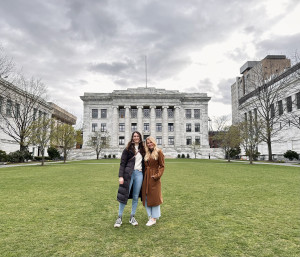
Flora Weber (left) and Darleen Hüser quickly found their way around the Harvard University campus. Pictured in the background is the famous Gordon Hall at Harvard Medical School.
© Privat
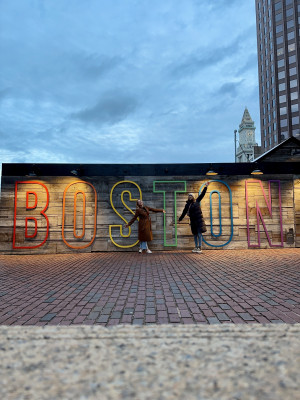
When the two young scientists are not conducting research in the lab, they explore the city of Boston and its surroundings. One highlight so far: in April, they were able to experience the famous Boston Marathon.
© Privat
(The interview was conducted by Clara Manthey, the protocol for the statements was conducted by Cheyenne Peters.)
